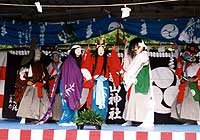
| Pseudonym reading | Kawaka Kagura |
|---|---|
| Specified type | Prefecture designation |
| Type | Intangible folk cultural property |
| Designated date | August 1, 1989 |
| Specified details | |
| quantity | |
| location | Oshu-shi Esashi Ward Hirose character valley ground rice field |
| owner | |
| Holding group | Serizawa Kagura Preservation Association |
| Management organization | |
| home page | Cultural Heritage Online (Serizawa Kagura) |
Overview
Serizawa Kagura is a Yamabushi Kagura that has the flow of the shame Kagura from Hayaikemine.
Otokogura Kagura is considered to have been established by the middle of the Muromachi period, but it seems that a sidestream was born in the Edo period, and after Kanura 9 years (1632) from Kashima Oshiri Norihiro, it passes through the land mark, and the Otokobo Hodori. It is said that Ayabe Ryukagura has been transferred to Yoshiaki.
After that, the law and seal of culture and culture administration year (1804-1830) Noguchi good strange called it a large accomplice mouth family and spread it in several places in the prefecture.
Serizawa Kagura learned about this Haruyama Kagura (Hanamaki-shi Towacho) and the flow of Kumishi-kagura (Oshu-shi Esashiku) in the beginning of the Meiji era, and transferred it in 1814. It was officially launched.
The performance is 36 acts, and it is roughly divided into expressions other than expressions and dances, and dances other than expressions are kamui, haramai, mamochi and samurai dance (Bankubu) and gongonmai is there.
After dedicating at the annual festival (September 4) of the Niiyama Shrine at the Kagura hall, and also at the beginning of the New Year's Day at the beginning of the new year, and dedicating it at the shrine at the spring festival (March 9), I go around each house.
Its style is based on the seven styles of large accompaniment Kagura, but it also conveys some of the large accompaniments, but some show uniqueness to dance patterns, structures, and structures.
On December 4, 1997, it was designated as an intangible folk cultural property that should take measures such as making a record of the country.
